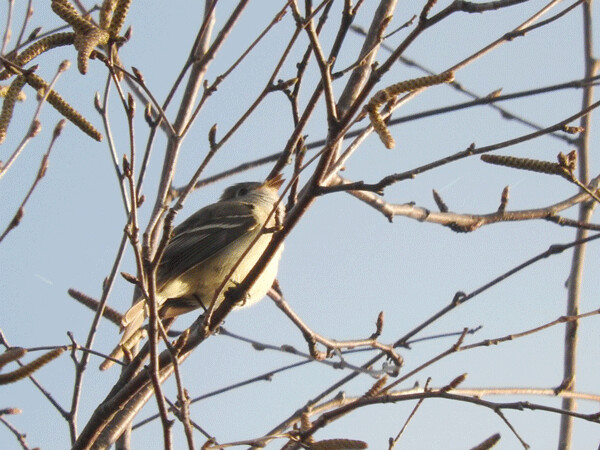News & Articles
Browse all content by date.

Birdsong filtered through the window screen even before the sunlight could. The day before, I’d woken up to the syncopated trill with a blisteringly high finale of Blackburnian warblers. Now there was a new voice in the mix. This was the second weekend in May, and each day a new wave of migrants swept in, contributing their songs to the growing chorus.
Although, I’m not sure I’d call the new addition a song exactly, at least in the traditional sense. The sound was a short, emphatic, “che-bec” with an insect-like quality and an accented second syllable. It took me two weeks of my first ornithology class to recognize this noise as coming from a bird. I didn’t even hear it at first; much less distinguish it from the other call notes and red squirrel chatter going on around me. Once I learned it, though, I heard it everywhere.
Occasionally I see the vocalist too, although that takes more work as the tree leaves emerge at breakneck speed and fill in the lacy network of twigs. Least flycatchers are cute little birds that weigh just over four pennies. Like most of their Empidonax flycatcher cousins, they have grayish-olive backs, whitish underparts, a white eye ring, and white wing bars.
They can often be spotted as they “hawk” for insects, which entails flying out from a perch, snatching a snack out of midair, and fluttering back to the same branch or another one nearby. This describes both the general appearance and behavior of a whole group of small, drab flycatchers in the Empidonax genus. Their songs are the most distinctive things about them. The reason that their voices are so distinctive fascinates me.
Other “true” songbirds will spend one period of brain development memorizing songs of adults, and the next phase trying to match them. This is true of the high-trilling Blackburnian warblers I heard earlier. If a songbird does not grow up with adults of its own species, or can’t hear, it does not develop a normal song. Flycatchers do not need to do either! They do not need to hear other adults in order to produce the typical che-bec song, and they do not even need to hear themselves to know that they are saying it correctly.
And yet, many birders would still consider these rote repetitions their “song.” You could say that the definition is based more on function than structure. A song, at least for many birders, is simply a sound made in order to establish and defend a territory, or to facilitate courtship and mating. With this definition, you can argue that the drumming of ruffed grouse and woodpeckers, booming of prairie chickens, and the wing sounds of a displaying woodcock are all “songs.”
In contrast, many birds also have shorter, simpler “calls,” that sound the alarm or keep members of a flock in contact.
While my morning walk was filled with least flycatchers che-bec-ing every twenty feet, and Blackburnian warblers trilling away, my evening stroll included a soundtrack by the common loon.
Loons are definitely not songbirds, but the males do have a distinctive territorial vocalization, known as the yodel. It’s a maniacal, up-and-down scream that clearly conveys the serious and stressful business of defending a territory (often at 3:00 a.m. when we’re trying to sleep), and each loon has his own version. The amazing thing is that when an invading loon is successful in winning a new territory, he will change his yodel. The new composition increases the difference between his yodel and that of the previous, defeated resident, while being careful not to stray too far outside of the norms for the neighborhood.
When comparing the loon’s ability to change his “song” throughout his lifetime in response to specific events, to the warbler’s reliance on a distinct period of brain development, and the flycatcher’s innate and immobile programming, well, it’s easy to be amazed by how many different ways there are to be successful. Each system works for the bird who uses it. I think maybe there’s a lesson in that?
Special Request: If you enjoy Emily’s book, Natural Connections: Exploring Northwoods Nature through Science and Your Senses, and think it should be available for more people to read, then take a moment and request it at your local library and bookstore! Order your copy at http://cablemuseum.org/natural-connections-book/. Listen to the podcast at www.cablemusum.org!
For 50 years, the Cable Natural History Museum has served to connect you to the Northwoods. Come visit us in Cable, WI! Our new exhibit: “Better Together--Celebrating a Natural Community” is now open!
| Tweet |


